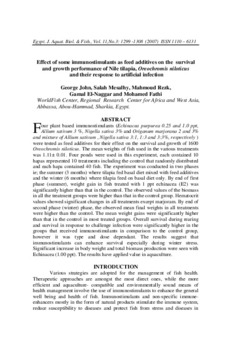Please use this identifier to cite or link to this item:
https://hdl.handle.net/20.500.12348/1737
Effect of some immunostimulants as feed additives on the survival and growth performance of Nile tilapia, Oreochromis niloticus and their response to artificial infection
| dc.creator | John, G. | |
| dc.creator | Mesalhy, S. | |
| dc.creator | Rezk, M.A. | |
| dc.creator | El-Naggar, G. | |
| dc.creator | Fathi, M. | |
| dc.date.accessioned | 2018-11-06T10:28:50Z | |
| dc.date.available | 2018-11-06T10:28:50Z | |
| dc.date.issued | 2007 | |
| dc.identifier | WF_946.pdf | |
| dc.identifier.citation | Egyptian journal of aquatic biology and fisheries 11(3):1299-1308 | |
| dc.identifier.issn | 1110-6131 | |
| dc.identifier.uri | https://hdl.handle.net/20.500.12348/1737 | |
| dc.description.abstract | Four plant based immunostimulants (Echinacea purpurea 0.25 and 1.0 ppt, Allium sativum 3 %, Nigella sativa 3% and Origanum marjorana 2 and 3% and mixture of Allium sativum , Nigella sativa 3:1, 1:3 and 3:3%, respectively ) were tested as feed additives for their effect on the survival and growth of 1600 Oreochromis niloticus. The mean weights of fish used in the various treatments was 1.11± 0.01. Four ponds were used in this experiment, each contained 10 hapas represented 10 treatments including the control that randomly distributed and each hapa contained 40 fish. The experiment was conducted in two phases ie; the summer (3 months) where tilapia fed basal diet mixed with feed additives and the winter (6 months) where tilapia feed on basal diet only. By end of first phase (summer), weight gain in fish treated with 1 ppt echinacea (E2) was significantly higher than that in the control. The observed values of the biomass in all the treatment groups were higher than that in the control group. Hematocrit values showed significant changes in all treatments except marjoram. By end of second phase (winter) phase, the observed mean final weights in all treatments were higher than the control. The mean weight gains were significantly higher than that in the control in most treated groups. Overall survival during rearing and survival in response to challenge infection were significantly higher in the groups that received immunostimulants in comparison to the control group, however it was type and dose dependant. The results suggest that immunostimulants can enhance survival especially during winter stress. Significant increase in body weight and total biomass production were seen with Echinacea (1.00 ppt). The results have applied value in aquaculture. | |
| dc.format | application/pdf | |
| dc.language | En | |
| dc.publisher | Egyptian Society for the Development of Fisheries and Human Health | |
| dc.source | Egyptian Journal of Aquatic Biology and Fisheries | |
| dc.title | Effect of some immunostimulants as feed additives on the survival and growth performance of Nile tilapia, Oreochromis niloticus and their response to artificial infection | |
| dc.type | Journal Article | |
| dcterms.bibliographicCitation | John, G. et al. (2007). Effect of some immunostimulants as feed additives on the survival and growth performance of Nile tilapia, Oreochromis niloticus and their response to artificial infection. Egyptian journal of aquatic biology and fisheries 11(3):1299-1308 | |
| dc.description.version | Peer Review | |
| cg.identifier.worldfish | 946 | |
| cg.subject.agrovoc | aquaculture | |
| cg.subject.agrovoc | diseases | |
| cg.subject.agrovoc | feeds | |
| cg.subject.agrovoc | fish diseases | |
| cg.subject.agrovoc | tilapia | |
| cg.subject.worldfish | feed | |
| cg.identifier.status | Open access | |
| cg.contribution.worldfishauthor | Mesalhy, S. | |
| cg.description.theme | Sustainable aquaculture |
Files in this item
This item appears in the following Collection(s)
-
Sustainable aquaculture [2735]
